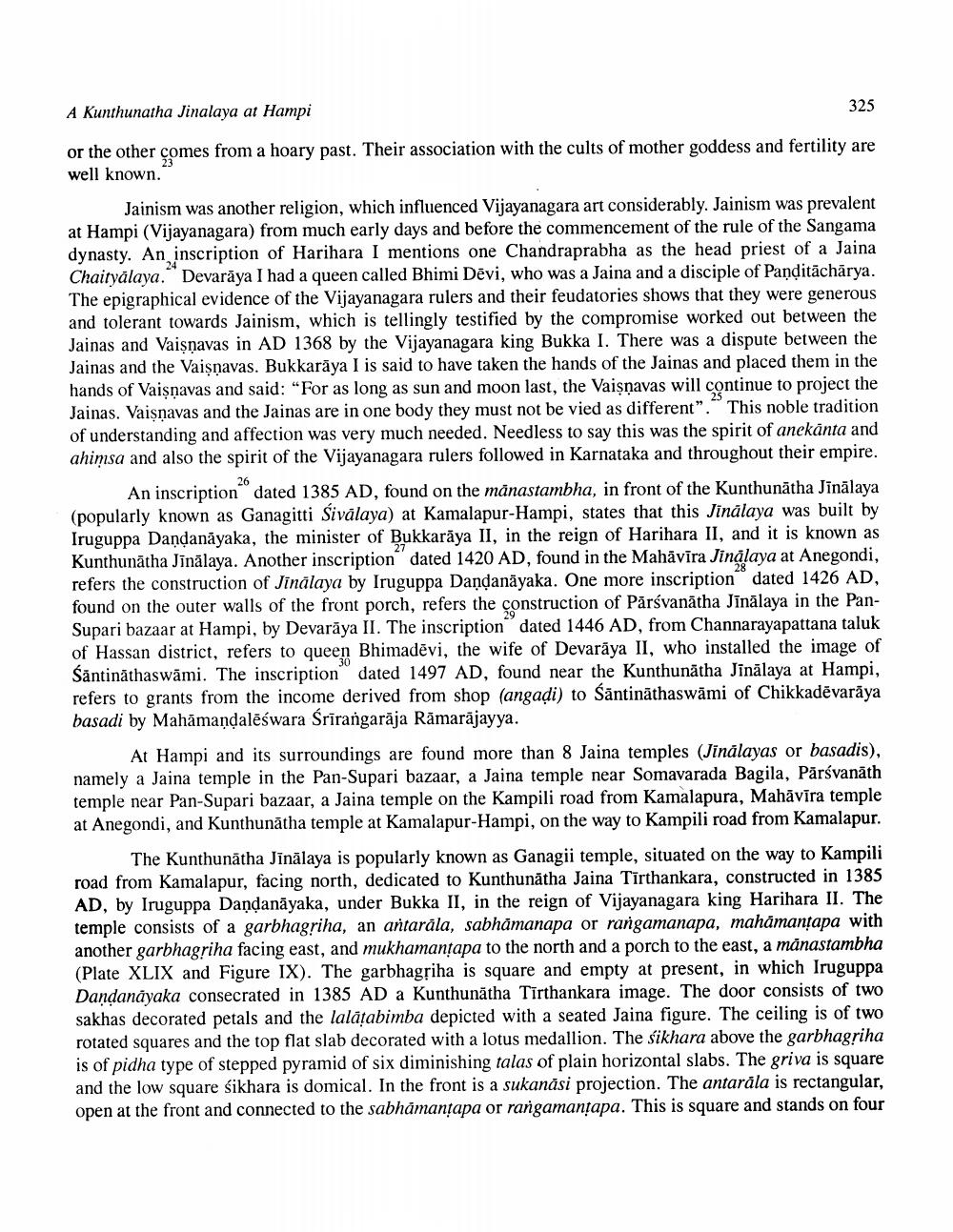________________
A Kunthunatha Jinalaya at Hampi
325
or the other comes from a hoary past. Their association with the cults of mother goddess and fertility are well known.
Jainism was another religion, which influenced Vijayanagara art considerably. Jainism was prevalent at Hampi (Vijayanagara) from much early days and before the commencement of the rule of the Sangama dynasty. An inscription of Harihara I mentions one Chandraprabha as the head priest of a Jaina Chaityälaya. Devaraya I had a queen called Bhimi Dēvi, who was a Jaina and a disciple of Panditāchārya. The epigraphical evidence of the Vijayanagara rulers and their feudatories shows that they were generous and tolerant towards Jainism, which is tellingly testified by the compromise worked out between the Jainas and Vaisnavas in AD 1368 by the Vijayanagara king Bukka I. There was a dispute between the Jainas and the Vaisnavas. Bukkarāya I is said to have taken the hands of the Jainas and placed them in the hands of Vaisnavas and said: "For as long as sun and moon last, the Vaisnavas will continue to project the Jainas. Vaisnavas and the Jainas are in one body they must not be vied as different"." This noble tradition of understanding and affection was very much needed. Needless to say this was the spirit of anekanta and ahiņsa and also the spirit of the Vijayanagara rulers followed in Karnataka and throughout their empire.
An inscription dated 1385 AD, found on the manastambha, in front of the Kunthunātha Jīnālaya (popularly known as Ganagitti Sivälaya) at Kamalapur-Hampi, states that this Jinālaya was built by Iruguppa Dandanāyaka, the minister of Bukkarāya II, in the reign of Harihara II, and it is known as Kunthunātha Jinālaya. Another inscription dated 1420 AD, found in the Mahāvīra Jinalaya at Anegondi, refers the construction of Jinālaya by Iruguppa Dandanāyaka. One more inscription dated 1426 AD, found on the outer walls of the front porch, refers the construction of Pārsvanātha Jīnālaya in the PanSupari bazaar at Hampi, by Devaraya II. The inscription dated 1446 AD, from Channarayapattana taluk of Hassan district, refers to queen Bhimadēvi, the wife of Devarāya II, who installed the image of śāntināthaswāmi. The inscription dated 1497 AD, found near the Kunthunātha Jinālaya at Hampi, refers to grants from the income derived from shop (angadi) to Santināthaswāmi of Chikkadēvarāya basadi by Mahāmandalēśwara Śrīrangarāja Rämarājayya.
At Hampi and its surroundings are found more than 8 Jaina temples (Jinalayas or basadis), namely a Jaina temple in the Pan-Supari bazaar, a Jaina temple near Somavarada Bagila, Pārsvanāth temple near Pan-Supari bazaar, a Jaina temple on the Kampili road from Kamalapura, Mahāvīra temple at Anegondi, and Kunthunātha temple at Kamalapur-Hampi, on the way to Kampili road from Kamalapur.
The Kunthunātha Jīnālaya is popularly known as Ganagii temple, situated on the way to Kampili road from Kamalapur, facing north, dedicated to Kunthunātha Jaina Tirthankara, constructed in 1385 AD, by Iruguppa Dandanāyaka, under Bukka II, in the reign of Vijayanagara king Harihara II. The temple consists of a garbhagriha, an antarala, sabhămanapa or rangamanapa, mahämantapa with another garbhagriha facing east, and mukhamantapa to the north and a porch to the east, a mănastambha (Plate XLIX and Figure IX). The garbhagriha is square and empty at present, in which Iruguppa Dandanayaka consecrated in 1385 AD a Kunthunātha Tīrthankara image. The door consists of two sakhas decorated petals and the lalátabimba depicted with a seated Jaina figure. The ceiling is of two rotated squares and the top flat slab decorated with a lotus medallion. The sikhara above the garbhagriha is of pidha type of stepped pyramid of six diminishing talas of plain horizontal slabs. The griva is square and the low square sikhara is domical. In the front is a sukanāsi projection. The antarala is rectangular, open at the front and connected to the sabhämantapa or rangamanțapa. This is square and stands on four




